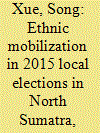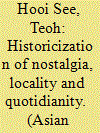|
|
|
Sort Order |
|
|
|
Items / Page
|
|
|
|
|
|
|
| Srl | Item |
| 1 |
ID:
160024


|
|
|
|
|
| Summary/Abstract |
Since Indonesia implemented the regional decentralization in 2001, ethnic politics attracted increasing scholarly attention. In the regional head elections, ethnic mobilization has become a pervasive phenomenon. Drawing upon the data in the 2015 local elections in the North Sumatra province, the article discusses two related questions, the strategy and the effect of ethnic mobilization. The article argues that, contrary to the minimum winning coalition theory, there is a weak correlation between the ethnic demography and the choice of ethnic mobilization strategy (bonding or bridging). Among all the ethnic mobilization tactics, the support of ethnic organizations may have a weak to moderate and positive impact on the voting results, while other tactics, including pairing with candidates of other ethnic groups and cultural presentations of ethnic identity, do not have much influence on the election results.
|
|
|
|
|
|
|
|
|
|
|
|
|
|
|
|
| 2 |
ID:
160019


|
|
|
|
|
| Summary/Abstract |
This article seeks to shed light on Lim Kim Chern’s gastronomic writing, by ensconcing this individual case in the context of Modern Chinese Prose as an enduring literary tradition, in order to elicit the attribute of locality with diasporic discourse in quotidian life, that distinguishes it as part of a work in Malaysian Chinese Literature than the others. We will further this quest, by comparing the gastronomic writing of Lim before and after the changes in his literary pursuit in gastronomic writing, namely, by the comparison of the literary hierarchy of high-brow literature and the sub-genre of literature that post-positions the literariness, in order to examine whether or not it is a revelation, or even a harbinger of the fate of Malaysian Chinese Literature being minor literature.
|
|
|
|
|
|
|
|
|
|
|
|
|
|
|
|
| 3 |
ID:
160021


|
|
|
|
|
| Summary/Abstract |
There are times when entire populations of certain countries have had to readjust their lives and economic strategies as all of society is under transition. Post-Soviet Central Asia underwent this period after 1991. During times of transition, there are always people that tend to be able to make use of the new uncertainties, even at the risk of entering legal grey areas. Here new social groups emerge, ethnic origin becomes relevant and new kinship ties are made. These transformation periods are often short and provide limited opportunities for analysing the strategies of those pioneers that I call Kairos economists. They often act only in cooperation with residents of the border and with duty customs and security personnel. This article analyses this special economy with the help of case studies that have been observed during the transformation period from the Soviet to an independent Central Asia.
|
|
|
|
|
|
|
|
|
|
|
|
|
|
|
|
| 4 |
ID:
160020


|
|
|
|
|
| Summary/Abstract |
The main objective of this study was to illustrate the cultural changes that have taken place among Korean ethnic groups living in the Central Asian states of the former Soviet Union. Previous research on Korean minorities has demonstrated the impact of state intervention on the formation of ethnic identity. Despite a wide range of regional differences, those living in Korea in the nineteenth century belonged to one ethnic group. Once they left the northern part of the country for Russia, they began to adopt Russian culture relatively quickly. Following their deportation to Central Asia in the 1930s, they then experienced a largely Soviet model of inclusion into mainstream society. However, since the 1980s, when confronted with ‘original’ Korean culture, they now consider themselves to be dissimilar to other Korean groups. The differences are already so substantial that Koreans themselves now talk about belonging to different nations.
|
|
|
|
|
|
|
|
|
|
|
|
|
|
|
|
| 5 |
ID:
160025


|
|
|
|
|
| Summary/Abstract |
For a few decades, socio-cultural as well as linguistic anthropologists have worked hard to construct a reliable semiotic paradigm to study linguistic, cultural and social interactions. These subfields – linguistic, cultural and social – are often analytically tackled asunder, though they are intimately interconnected, intertwined and overlapping. The semiotic theory of culture is not a novel discovery in itself, but it can also be applied to the study of society and ethnicity. Culture, society and ethnicity are systems of communication, that is systems of signs; society is a system of signs whose meaning emerges from social interactions and ethnicity a system of signs whose meaning is strategically imposed by a specific society through a specific culture. Moreover, those three systems of communication, of signs, are interconnected in various ways. This essay will analyze ‘Taiwanese Ethnicity’ in its semiotic dimension, and explore how society, culture and ethnicity interact in constructing an ethnic identification.
|
|
|
|
|
|
|
|
|
|
|
|
|
|
|
|
| 6 |
ID:
160023


|
|
|
|
|
| Summary/Abstract |
Prevalence of stunting among India’s tribal under-five children has witnessed a 3% annual decline in the last 8 years. Cross-sectional data of 1000 children (287 tribal and 713 non-tribal) aged 0–23 months from Odisha’s Rapid Survey of Children (RSOC, 2014) was analysed to identify the predictors of stunting and severe stunting among tribal children and to suggest policy and programme implications. Results show significant determinants of childhood stunting to be birth order, maternal illiteracy and determinants for severe stunting were maternal age <18 years at marriage and <20 years at birth, and <3 antenatal clinic visits. Severe stunting in tribal children was predicted by basic causes: poverty and maternal age <20 years at first birth and age <18 years at marriage. Findings strongly suggest to accelerate efforts towards reducing childhood stunting in Odisha more specifically among tribal children for whom a special strategy is urgently warranted.
|
|
|
|
|
|
|
|
|
|
|
|
|
|
|
|
| 7 |
ID:
160022


|
|
|
|
|
| Summary/Abstract |
Chavang Kut, a post-harvesting festival in Manipur, represents an important cultural expression of the Chin-Kuki-Mizo group of people. The article looks at the participation of the Thadou community in the celebration by tracing their performative historiography. In the past, the celebration was primarily important in the religio-cultural sense. The rhythmic movements of the dances in the festival were inspired by animals, agricultural techniques and showed their relationship with ecology. Today, the celebration witnesses the shifting of stages and is revamped to suit new contexts and interpretations. The traditional dances which forms the core of the festival is now performed in the out-of-village settings and are staged in a secular public sphere. While used by the state as a political project to bring unity amongst the different communities of Manipur, recent socio-political occasions showed how it is used as a site of contestations against the state.
|
|
|
|
|
|
|
|
|
|
|
|
|
|
|
|
|
|
|
|
|